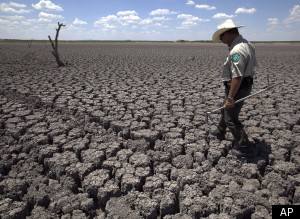
In a muddy pile of sand where a pond once flowed in the Texas Panhandle, dead fish, their flesh already decayed and feasted on by maggots, lie with their mouths open. Nearby, deer munch on the equivalent of vegetative junk food and wild turkeys nibble on red harvester ants – certainly not their first choice for lunch.
As the state struggles with the worst one-year drought in its history, entire ecosystems, from the smallest insects to the largest predators, are struggling for survival. The foundations of their habitats – rivers, springs, creeks, streams and lakes – have turned into dry sand, wet mud, trickling springs or, in the best case, large puddles.
"It has a compound effect on a multitude of species and organisms and habitat types because of the way that it's chained and linked together," said Jeff Bonner, a wildlife biologist with the Texas Parks and Wildlife Department.
Since January, Texas has only gotten about 6 inches of rain, compared to a norm of about 13 inches, making it the most severe one-year drought on record. Last week, the U.S. Climate Prediction Center said the La Nina weather pattern blamed for the lack of rain might be back soon, and if that happens, the dry spell would almost certainly extend into 2012.
The extreme dry conditions, which have extended into parts of the Plains including Oklahoma and Kansas, have been made worse by week after week of triple-digit temperatures that have caused reservoirs to evaporate, crops to wither and animals and fish to die.
Already, some rivers and lakes are at lows not seen since the 1950s – the decade when Texas suffered its worst drought in recorded history. And in some cases, bodies of water are at their lowest points ever, said Joseph Capesius, chief of the Austin field unit for the U.S. Geological Survey.
Of the state's 3,700 streams, 15 major rivers and more than 200 reservoirs at least seven reservoirs are effectively empty and more than half of the streams and rivers are at below normal flow rates.
The drought will most immediately cause fish to die and such kills have already happened in parts of the state, including not far from the Canadian River, a normally flowing river in the Panhandle that in some places is barely a puddle fed by a drought-taxed spring. In West Texas, O.C. Fisher Lake has been so depleted that fish have died from a lack of oxygen and bacteria has turned the remaining water red.
Without water, animals struggle with thirst. Few plants grow.
Without plants, there are fewer insects. No insects result in low seed production. The animals that rely on seeds and plants for nutrition – from birds to deer and antelope – have low reproduction. Predators that rely on those animals as a food source remain hungry as well, and they reproduce less.
"So there's a domino effect that goes out in however many more branches than you can actually ever keep count of," Bonner said.
The long-term impact from the drought will cross state lines and country borders because Texas is so large and its ecosystems diverse.
For example, birds that migrate south in the winter will find little food and water this year in Texas so they will have to fly even farther south and expend more energy. As a result, they could reproduce less. Some of those birds, such as the colorful painted bunting, often fly to Central America for part of the year where there has been a lot of rain and more insects than usual. But because of the drought in Texas and the Plains, there may not be enough birds to consume the insects, Bonner said.
"Now, what happens?" Bonner said. "Continentally speaking, this big of an area not getting enough water can impact places far and wide."
The impact on species also could last for years after the drought officially ends. For example, quail normally nest in grass grown a year earlier, but because of the drought, there has been almost no grass growth this year. That means many quail won't be able to nest next year and the impact of the drought on the birds won't be seen until 2012, Bonner said.
With deer, the true impact may not be revealed for six years when the low reproduction rates caused by the drought will leave an age gap between older bucks and younger deer.
Prairie chickens will also reproduce less due to the drought – something that could spell more trouble for the species. In the past decade, the chickens' numbers have dropped so significantly that the federal government may place them on an endangered species list, a move that would make it illegal to hunt and force conservation of prairie chicken habitats.
John Baccus, a wildlife biologist at Texas State University in San Marcos, said he is most immediately concerned with bats and song birds, both of which rely on insects for food. Baccus believes that some females will not have any offspring this year due to a poor diet. Whatever babies are born will likely have a low survival rate because they are entering a world with a scarce food supply.
Already, Baccus said, he has noticed white-tailed deer looking skinnier than usual, their ribs jutting out. As a result, the mothers are producing less milk and the newest crop of fawns will be weaned at sub-par weight.
"It's an ecosystem-wide problem," Baccus said.
Article courtesy of huffingtonpost.com

